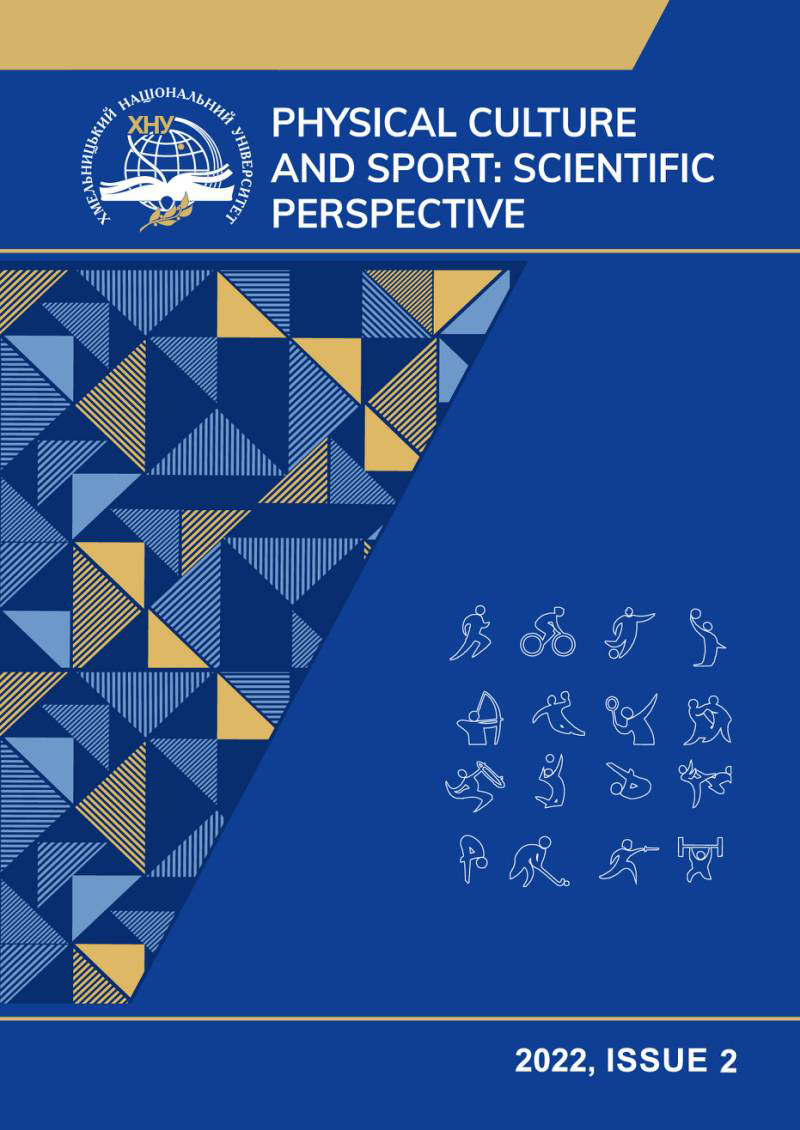DETERMINATION OF THE MODEL CHARACTERISTICS OF THE TRAJECTORY OF THE MOVEMENT IN CLEAN-AND-JERK USED BY FEMALE WEIGHTLIFTERS OF HIGH QUALIFICATION
DOI:
https://doi.org/10.31891/pcs.2022.2.11Keywords:
weightlift, clean-and-jerk, horizontal weights movement, trajectory typesAbstract
Nowadays, when information technologies have taken an important place in the training of athletes, especially in the work on technique, the problem of forming a base of model indicators of the technique of performing competitive movements by athletes has become urgent. Thanks to such data of model indicators, programmers can create specialized content that helps both the coach and the athlete to analyze their own technical actions.
The article examines the competitive activity of highly qualified weightlifters and analyzes the trajectory of the barbell movement in the first push exercise - lifting the barbell to the chest.
The main goal of the study was to determine the types of trajectory of barbell movements to the chest by high-class weightlifters. The research analyzed the attempts of 140 highly qualified weightlifters. As a result of the analysis of successful attempts at lifting barbells on the chest during performance at international competitions, it was possible to obtain the ratio of possession of highly qualified weightlifters of the horizontal trajectory of movement in accordance with different weight categories. As a result of the conducted research, data were obtained that show a significant advantage of the use of the first type (A) bar movement trajectory in clean-and-jerk lift by highly qualified female weightlifters. It has been defined that the second type of trajectory (B) in clean-and-jerk lift is more used by female weightlifters in lightweight categories (48-58 kg). It has been found that female athletes (53) and female athletes in heavyweight category (75+) use the third type of barbell motion trajectory (C).
References
Akkuş, H. Kinematic analysis of the snatch lift with elite female weightlifters during the 2010 World Weightlifting Championship. J. Strength Cond. Res. 2012, 26, 897–905.
Antonio U. Weightlifting. Sport for all sports / Antonio Urso // Copyright: Calzetti & Mariucci Publishers:. Topografia Mancini. – May 2011. – 176 р.
Antoniuk O.V., & Pavlyuk E.A. (2016) Characteristics of barbell trajectory in snatch, fulfilled by elite female weight-lifters. Pedagogics, psychology, medical-biological problems of physical training and sports, 2016;6:4–8.
Baumann, W, Gross, V, Quade, K, Galbierz, P, and Schwirtz, A. The snatch technique of world class weight lifters at the 1985 world championships.Int J Sport Biomech 4: 68–89, 1998.
Campos J. Kinematical analysis of the snatch in elite male junior weightlifters of different weight categories / J. Campos, P. Poletaev, A. Cuesta, C. Pablos, V. Carratalá // J Strength Cond Res.– 2006 Nov.– №20(4).– Р. 843–50.
Garhammer, J. Bar trajectories of world champion male and female weightlifters: Coaching applications, Part 1. Int Olympic Lifter10: 7–8, 1990.
Garhammer, J. Weightlifting performance and techniques of men and women. In:First International Conference on Weightlifting and Strength Training. P.V. Komi, ed. Lahti, Finland: Gummerus Printing, 1998. pp. 89–94.
Gourgoulis, V, Aggeloussis, N, Mavromatis, G, and Garas, A. Threedimensional kinematic analysis of the snatch of elite Greek weightlifters.J Sport Sci18: 643–652, 2000.
Hancock S., Wyatt F., and Kilgore L. Variation in Barbell Position Relative to Shoulder and Foot Anatomical Landmarks Alters Movement Efficiency. International Journal of Exercise Science 5(3) : 183-195, 2012.
Hasan Akkusx. Kinematic analysis of the snatch lift with elite female weightlifters during the 2010 World Weightlifting Championship.J Strength Cond Res26(4): 897–905, 2012.
Hiskia, G. Biomechanical analysis of world and Olympic champion weightlifters performance. In:Proceedings of the Weightlifting Symposium. A. Lukacsfalvi and F. Takacs, eds. Budapest, Hungary: IWF, 1997. pp. 137–158.
Hoover, DL, Carlson, KM, Christensen, BK, and Zebas, CJ.Biomechanical analysis of women weightlifters during the snatch. J Strength Cond Res20: 627–633, 2006.
Ikeda, Y, Jinji, T, Matsubayashi, T, Matsuo, A, Inagaki, E, Takemata, T, and Kikuta, M. Comparison of the snatch technique for female weightlifters at the 2008 Asian Championships.J Strength Cond Res26: 1281–1295, 2012.
Korkmaz S, Harbili E. Biomechanical analysis of the snatch technique in junior elite female weightlifters. / S. Korkmaz, E. Harbili // Journal of Sports Sciences. – 2016 Jun 2. – № 34(11). – рр. 1088-93.
Musser, Leslie J. "The effect of anthropometry on barbell trajectory for elite female weightlifters at the 2009 pan american championships." PhD diss., CALIFORNIA STATE UNIVERSITY, LONG BEACH, 2010., 86 pages; 1486708.
Musser, LJ, Garhammer, J, Rozenek, R, Crussemeyer, JA, and Vargas, EM. Anthropometry and barbell trajectory in the snatch lift for elite women weightlifters. J Strength Cond Res 28(6): 1636–1648, 2014
Nejadian S.L., Rostami M., Naghash A. Cost evaluation of different snatch trajectories by using dynamic programming method / 8th Conference of the International Sports Engineering Association. Procedia Engineering 2 (2010) 2563–2567
Okada, J, Iijima, K, Fukunaga, T, Kikuchi, T, and Kato, K. Kinematic analysis of the snatch technique used by Japanese and international female weightlifters at the 2006 Junior World Championships. Int J Sport Health Sci6: 194–202, 2008.
Oleshko V.G. Training of athletes in strength sports: {{Educational guide}}. / V.G. Oleshko - K.: DIA, 2011. - 444 p.
Petrizzo J, DiMenna FJ, Page R, Smith G, Martins K, Lester J, Kang S, Chandler L, Wygand JW, Otto RM. Altered Start Position Reduces Horizontal Displacement during the Snatch and Clean. JEPonline 2016;19(3):24-34.
Schilling В., Stone M., O'Bryant H., Fry A.C., Coglianese R., Pierces K.. Snatch Technique of Collegiate National Level Weightlifters // Journal of Strength and Conditioning Research, - 2002.- No. 16(4).- P. 551-555.
Stephen J. Rossi, Thomas W. Buford, Douglas B. Smith, Robin Kennel, Erin E. Haff, and G. Gregory Haff. Bilateral Comparison of Barbell Kinetics and Kinematics During a Weightlifting Competition. International Journal of Sports Physiology and Performance, 2007;2:150-158.
Tovstonoh.O. Individualization technical training weightlifting at the stage of specialized basic training. Ldufk. Lviv. 2012. Electronic repository. https://repository.ldufk.edu.ua/bitstream/34606048/8047/1/tovstonoh_o_i.PDF





